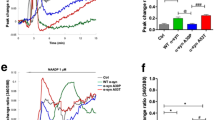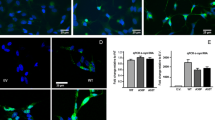Abstract
Deterioration of energy metabolism in affected cells is an important feature of synucleinopathies, including Parkinson's disease. Here, we studied the association between α-synuclein accumulation and glycolysis using SH-SY5Y neuroblastoma cell lines stably expressing wild-type α-synuclein or its A53T mutant linked to the autosomal dominant form of the disease. Overexpression of both proteins led to the accumulation of thioflavin S-positive aggregates, more pronounced for α-synuclein A53T. It also caused changes in the cell energy metabolism manifested as a decrease in the lactate accumulation and glucose uptake. Impairments in glycolysis were also accompanied by a decrease in the activity of the glycolytic enzyme glyceraldehyde-3-phosphate dehydrogenase (GAPDH). In vitro experiments with purified proteins indicated that GAPDH inactivation might be caused by its binding to the monomeric and oligomeric forms of α-synuclein. Therefore, a decrease in the GAPDH activity induced by its interaction with α-synuclein, might be one of the causes of glucose metabolism deterioration in synucleinopathies.





Similar content being viewed by others
Abbreviations
- α-synWT:
-
α-synuclein wild-type
- α-synA53T:
-
α-synuclein A53T
- CD:
-
circular dichroism
- GAPDH:
-
glyceraldehyde-3-phosphate dehydrogenase
- hGAPDH:
-
recombinant human GAPDH
- G3P:
-
glyceraldehyde-3-phosphate
- PBS:
-
phosphate buffered saline, pH 7.4
- PD:
-
Parkinson’s disease
- ThS:
-
thioflavin S
- ThT:
-
thioflavin
REFERENCES
Schapira, A., Cooper, J., Dexter, D., Clark, J., Jenner, P., and Marsden, C. (1990) Mitochondrial complex I deficiency in Parkinson’s disease, J. Neurochem., 54, 823-827, doi: 10.1111/j.1471-4159.1990.tb02325.x.
Nakamura, K. (2013) α-Synuclein and mitochondria: partners in crime? Neurotherapeutics, 10, 391-9, doi: 10.1007/s13311-013-0182-9.
Henchcliffe, C., Shungu, D., Mao, X., Huang, C., Nirenberg, M., Jenkins, B., and Beal, M. (2008) Multinuclear magnetic resonance spectroscopy for in vivo assessment of mitochondrial dysfunction in Parkinson’s disease, Ann. N. Y. Acad. Sci., 1147, 206-20, doi: 10.1196/annals.1427.037.
Jiang, P., Gan, M., Ebrahim, A., Castanedes-Casey, M., Dickson, D., and Yen, S. (2013) Adenosine monophosphate-activated protein kinase overactivation leads to accumulation of α-synuclein oligomers and decrease of neurites, Neurobiol. Aging, 34, 1504-1515, doi: 10.1016/j.neurobiolaging.2012.11.001.
Anandhan, A., Lei, S., Levytskyy, R., Pappa, A., Panayiotidis, M., Cerny, R., Khalimonchuk, O., Powers, R., and Franco, R. (2017) Glucose metabolism and AMPK signaling regulate dopaminergic cell death induced by gene (α-synuclein)-environment (paraquat) interactions, Mol. Neurobiol., 54, 3825-3842, doi: 10.1007/s12035-016-9906-2.
Anandhan, A., Jacome, M., Lei, S., Hernandez-Franco, P., Pappa, A., Panayiotidis, M., Powers, R., and Franco, R. (2017) Metabolic dysfunction in Parkinson’s disease: bioenergetics, redox homeostasis and central carbon metabolism, Brain Res. Bull., 133, 12-30, doi: 10.1016/j.brainresbull.2017.03.009.
Herrero-Mendez, A., Almeida, A., Fernández, E., Maestre, C., Moncada, S., and Bolaños, J. (2009) The bioenergetic and antioxidant status of neurons is controlled by continuous degradation of a key glycolytic enzyme by APC/C-Cdh1, Nat. Cell Biol., 11, 747-52, doi: 10.1038/ncb1881.
Dunn, L., Allen, G, Mamais, A., Ling, H., Li, A., Duberley, K., Hargreaves, I., Pope, S., Holton, J., Lees, A., Heales, S., and Bandopadhyay, R. (2014) Dysregulation of glucose metabolism is an early event in sporadic Parkinson’s disease, Neurobiol. Aging, 35, 1111-1115, doi: 10.1016/j.neurobiolaging.2013.11.001.
Polymeropoulos, M., Lavedan, C., Leroy, E., Ide, S., Dehejia, A., Dutra, A., Pike, B., Root, H., Rubenstein, J., Boyer, R., Stenroos, E., Chandrasekharappa, S., Athanassiadou, A., Papapetropoulos, T., Johnson, W., Lazzarini, A., Duvoisin, R., Iorio, G., Golbe, L., and Nussbaum, R. (1997) Mutation in the alpha-synuclein gene identified in families with Parkinson’s disease, Science, 276, 2045-2047, doi: 10.1126/science.276.5321.2045.
Krüger, R., Kuhn, W., Müller, T., Woitalla, D., Graeber, M., Kösel, S., Przuntek, H., Epplen, J., Schöls, L., and Riess, O. (1998) Ala30Pro mutation in the gene encoding alpha-synuclein in Parkinson’s disease, Nat. Genet., 18, 106-108, doi: 10.1038/ng0298-106.
Zarranz, J., Alegre, J., Gómez-Esteban, J., Lezcano, E., Ros, R., Ampuero, I., Vidal, L., Hoenicka, J., Rodriguez, O., Atarés, B., Llorens, V., Tortosa, E., Ser, T., Muñoz, D., and Yebenes, J. (2004) The new mutation, E46K, of alpha-synuclein causes Parkinson and Lewy body dementia, Ann. Neurol., 55, 164-173, doi: 10.1002/ana.10795.
Chartier-Harlin, M-C., Kachergus, J., Roumier, C., Mouroux, V., Douay, X., Lincoln, S., Levecque, C., Larvor, L., Andrieux, J., Hulihan, M., Waucquier, N., Defebvre, L., Amouyel, P., Farrer, M., and Destée, A. (2004) Alpha-synuclein locus duplication as a cause of familial Parkinson’s disease, Lancet (London, England), 364, 1167-1169, doi: 10.1016/S0140-6736(04)17103-1.
Singleton A., Farrer, M., Johnson, J., Singleton, A., Hague, S., Kachergus, J., Hulihan, M., Peuralinna, T., Dutra, A., Nussbaum, R., Lincoln, S., Crawley, A., Hanson, M., Maraganore, D., Adler, C., Cookson, M., Muenter, M., Baptista, M., Miller, D., Blancato, J., Hardy, J., and Gwinn-Hardy, K. (2003) Alpha-synuclein locus triplication causes Parkinson’s disease, Science, 302, 841, doi: 10.1126/science.1090278.
Shalova, I., Cechalova, K., Rehakova, Z., Dimitrova, P., Ognibene, E., Caprioli, A., Schmalhausen, E., Muronetz, V., and Saso, L. (2007) Decrease of dehydrogenase activity of cerebral glyceraldehyde-3-phosphate dehydrogenase in different animal models of Alzheimer’s disease, Biochim. Biophys. Acta, 1770, 826-832, doi: 10.1016/j.bbagen.2007.01.014.
Mazzola, J., and Sirover, M. (2001) Reduction of glyceraldehyde-3-phosphate dehydrogenase activity in Alzheimer’s disease and in Huntington’s disease fibroblasts, J. Neurochem., 76, 442-449, doi: 10.1046/j.1471-4159.2001.00033.x.
Tatton, N. (2000) Increased caspase 3 and Bax immunoreactivity accompany nuclear GAPDH translocation and neuronal apoptosis in Parkinson’s disease, Exp. Neurol., 166, 29-43, doi: 10.1006/exnr.2000.7489.
Tsuchiya, K., Tajima, H., Kuwae, T., Takeshima, T., Nakano, T., Tanaka, M., Sunaga, K., Fukuhara, Y., Nakashima, K., Ohama, E., Mochizuki, H., Mizuno, Y., Katsube, N., and Ishitani, R. (2005) Pro-apoptotic protein glyceraldehyde-3-phosphate dehydrogenase promotes the formation of Lewy body-like inclusions, Eur. J. Neurosci., 21, 317-326, doi: 10.1111/j.1460-9568.2005.03870.x.
Barinova, K., Khomyakova, E., Semenyuk, P., Schmalhausen, E., and Muronetz, V. (2018) Binding of alpha-synuclein to partially oxidized glyceraldehyde-3-phosphate dehydrogenase induces subsequent inactivation of the enzyme, Arch. Biochem. Biophys., 642, 10-22, doi: 10.1016/j.abb.2018.02.002.
Barinova, K., Kuravsky, M., Arutyunyan, A., Serebryakova, M., Schmalhausen, E., and Muronetz, V. (2017) Dimerization of Tyr136Cys alpha-synuclein prevents amyloid transformation of wild-type alpha-synuclein, Int. J. Biol. Macromol., 96, 35-43, doi: 10.1016/j.ijbiomac.2016.12.011.
Bradford, M. (1976) A rapid and sensitive method for the quantitation of microgram quantities of protein utilizing the principle of protein-dye binding, Anal. Biochem., 72, 248-254, doi: 10.1006/abio.1976.9999.
Danshina, P., Schmalhausen, E., Avetisyan, A., and Muronetz, V. (2001) Mildly oxidized glyceraldehyde-3-phosphate dehydrogenase as a possible regulator of glycolysis, IUBMB Life, 51, 309-314, doi: 10.1080/152165401317190824.
Barinova, K., Eldarov, M., Khomyakova, E., Muronetz, V., and Schmalhausen, E. (2017) Isolation of recombinant human untagged glyceraldehyde-3-phosphate dehydrogenase from E. coli producer strain, Protein Expr. Purif., 137, 1-6, doi: 10.1016/j.pep.2017.06.009.
Lee, B., and Kamitani, T. (2019) Improved immunodetection of endogenous α-synuclein, PLoS One, 6, e23939, doi: 10.1371/journal.pone.0023939.
Medvedeva, M., Barinova, K., Melnikova, A., Semenyuk, P., Kolmogorov, V., Gorelkin, P., Erofeev, A., and Muronetz, V. (2020) Naturally occurring cinnamic acid derivatives prevent amyloid transformation of alpha-synuclein, Biochimie, 170, 128-139, doi: 10.1016/j.biochi.2020.01.004.
Liu, Z., Yu, Y., Li, X., Ross, C., and Smith, W. (2011) Curcumin protects against A53T alpha-synuclein-induced toxicity in a PC12 inducible cell model for Parkinsonism, Pharmacol. Res., 63, 439-444, doi: 10.1016/j.phrs.2011.01.004.
Mishizen, A. J., Lynch, D. R., Nakashima, A., Nagatsu, T., Giasson, B. I., Ota, A., Thomas, S. A., Mazzulli, J. R., and Ischiropoulos, H. (2006) Cytosolic catechols inhibit α-synuclein aggregation and facilitate the formation of intracellular soluble oligomeric intermediates, J. Neurosci., 26, 10068-78, doi: 10.1523/jneurosci.0896-06.2006.
Marmolino, D., Foerch, P., Atienzar, F., Staelens, L., Michel, A., and Scheller, D. (2016) Alpha-synuclein dimers and oligomers are increased in overexpressing conditions in vitro and in vivo, Mol. Cell. Neurosci., 71, 92-101, doi: 10.1016/J.MCN.2015.12.012.
Burré, J., Vivona, S., Diao, J., Sharma, M., Brunger, A., and Südhof, T. (2013) Properties of native brain α-synuclein, Nature, 498, 1-6, doi: 10.1038/nature12125.
Funding
The work was supported by the Russian Foundation for Basic Research (project No. 18-34-00132).
Author information
Authors and Affiliations
Corresponding author
Ethics declarations
This article does not contain descriptions of studies with participation of humans or animals performed by any of the authors. The authors declare no conflict of interest.
Rights and permissions
About this article
Cite this article
Melnikova, A., Pozdyshev, D., Barinova, K. et al. α-Synuclein Overexpression in SH-SY5Y Human Neuroblastoma Cells Leads to the Accumulation of Thioflavin S-positive Aggregates and Impairment of Glycolysis. Biochemistry Moscow 85, 604–613 (2020). https://doi.org/10.1134/S0006297920050090
Received:
Revised:
Accepted:
Published:
Issue Date:
DOI: https://doi.org/10.1134/S0006297920050090




